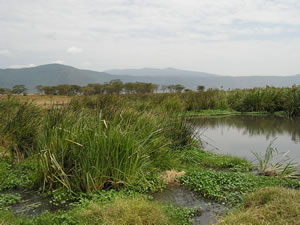Trees and Water in the Soil
 Trees
effect on water does not stop with occult precipitation. Trees, shrubs
and grasses are very important in stopping soil erosion and enhancing
moisture penetration in soils. When rain falls, it builds up energy
according to drop size and speed. The large drops of East African
thunderstorms contain high energy that is released when it hits the
ground. On bare earth this can loosen topsoil, causing it to move
down a slope with runoff. This is termed sheet erosion. Sometimes
this water, containing topsoil, forms rivulets that dig deeper into
soils causing gullies. Trees and grasses break the energy of falling
rain. Instead of loosening soil, it follows the stem down, gently
reaching the ground. In a `trees only' area runoff and gullying still
occurs, but not as rapidly. With trees and grasses, water would be
trapped, and penetrate the soil. Many eroded sites in Kenya, especially
in semi-arid areas, would look far different if a tree and grass cover
remained.
Trees
effect on water does not stop with occult precipitation. Trees, shrubs
and grasses are very important in stopping soil erosion and enhancing
moisture penetration in soils. When rain falls, it builds up energy
according to drop size and speed. The large drops of East African
thunderstorms contain high energy that is released when it hits the
ground. On bare earth this can loosen topsoil, causing it to move
down a slope with runoff. This is termed sheet erosion. Sometimes
this water, containing topsoil, forms rivulets that dig deeper into
soils causing gullies. Trees and grasses break the energy of falling
rain. Instead of loosening soil, it follows the stem down, gently
reaching the ground. In a `trees only' area runoff and gullying still
occurs, but not as rapidly. With trees and grasses, water would be
trapped, and penetrate the soil. Many eroded sites in Kenya, especially
in semi-arid areas, would look far different if a tree and grass cover
remained.
Rainwater, after entering the
soil, has to go somewhere. Often it follows tree root channels, even
reaching through hardpans, recharging the water table. From there
it may reappear in springs, or be recaptured by roots and re-enter
the atmosphere via transpiration. Some evidence indicates that deforested
areas may lose their water tables, causing springs to dry. Reforestation
can recharge this water table by increasing occult precipitation in
appropriate areas, decreasing surface runoff, and increasing soil
penetration. This effect has not been confirmed conclusively but there
is important evidence that this happens. Removing a forest from a
city watershed supply adversely affects both quantity and quality
of the supply.
On steep slopes trees play
an even greater role in erosion control. Tree roots, unlike most grasses,
and shrubs like tea or coffee, penetrate deeply into the soil. Their
great shear strength prevents soil slippage on slopes of more than
30 percent. Some tea fields grow on slopes greater than this. Tea
plants do capture all the water falling on a field, but their roots
are not deep. Water builds up in the upper layers of the soil creating
a situation where the upper layers can slip over the dryer, deeper
layers. Trees, like Grevillea robusta , planted at 10 x 20 metre spacing
in these fields, would greatly reduce this problem without affecting
yields. Other steep farmed slopes should include trees for this reason,
unless they are properly terraced.